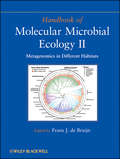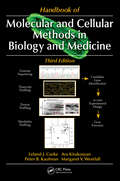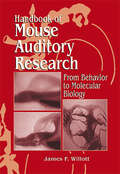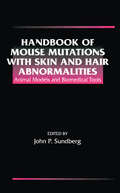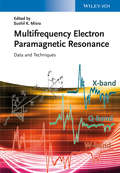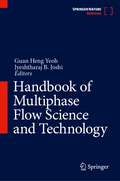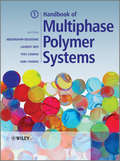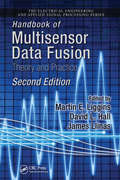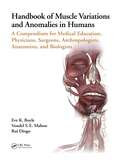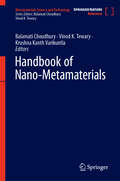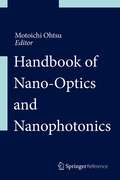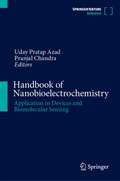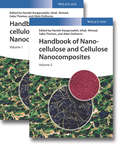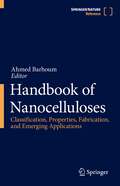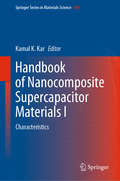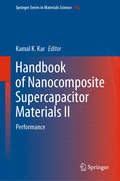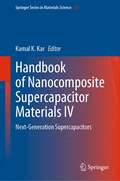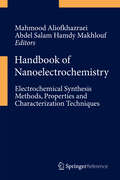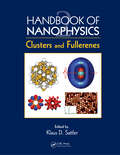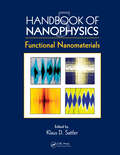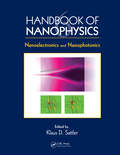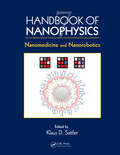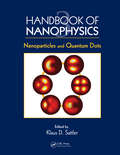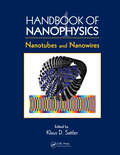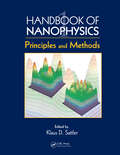- Table View
- List View
Handbook of Molecular Microbial Ecology II: Metagenomics in Different Habitats
by Frans J. de BruijnThe premiere two-volume reference on revelations from studying complex microbial communities in many distinct habitats Metagenomics is an emerging field that has changed the way microbiologists study microorganisms. It involves the genomic analysis of microorganisms by extraction and cloning of DNA from a group of microorganisms, or the direct use of the purified DNA or RNA for sequencing, which allows scientists to bypass the usual protocol of isolating and culturing individual microbial species. This method is now used in laboratories across the globe to study microorganism diversity and for isolating novel medical and industrial compounds. Handbook of Molecular Microbial Ecology is the first comprehensive two-volume reference to cover unculturable microorganisms in a large variety of habitats, which could not previously have been analyzed without metagenomic methodology. It features review articles as well as a large number of case studies, based largely on original publications and written by international experts. This second volume, Metagenomics in Different Habitats, covers such topics as: Viral genomes Metagenomics studies in a variety of habitats, including marine environments and lakes, soil, and human and animal digestive tracts Other habitats, including those involving microbiome diversity in human saliva and functional intestinal metagenomics; diversity of archaea in terrestrial hot springs; and microbial communities living at the surface of building stones Biodegradation Biocatalysts and natural products A special feature of this book is the highlighting of the databases and computer programs used in each study; they are listed along with their sites in order to facilitate the computer-assisted analysis of the vast amount of data generated by metagenomic studies. Such studies in a variety of habitats are described here, which present a large number of different system-dependent approaches in greatly differing habitats. Handbook of Molecular Microbial Ecology II is an invaluable reference for researchers in metagenomics, microbial ecology, microbiology, and environmental microbiology; those working on the Human Microbiome Project; microbial geneticists; and professionals in molecular microbiology and bioinformatics.
Handbook of Molecular and Cellular Methods in Biology and Medicine
by Ara Kirakosyan Peter B. Kaufman Leland J. Cseke Margaret V. WestfallSeveral milestones in biology have been achieved since the first publication of the Handbook of Molecular and Cellular Methods in Biology and Medicine. This is true particularly with respect to genome-level sequencing of higher eukaryotes, the invention of DNA microarray technology, advances in bioinformatics, and the development of RNAi technology
Handbook of Mouse Auditory Research: From Behavior to Molecular Biology
by James F. WillottThis unique compilation of chapters reviews a broad range of topics at the cutting edge of hearing research. The authors include many of the top auditory scientists in the world as well as some of the brightest rising stars. Although the book obviously focuses on the exciting, revolutionary work being done with mice, the authors have made a strong
Handbook of Mouse Mutations with Skin and Hair Abnormalities: Animal Models and Biomedical Tools
by John P. SundbergHandbook of Mouse Mutations with Skin and Hair Abnormalities presents 48 mouse mutations that are all available to the biomedical community. Many of the mouse mutations with dermatological diseases are reviewed and illustrated in detail. This popular reference book gives you a single source to use when determining which mouse mutation will best serve your needs as a biomedical tool for sophisticated research projects. The book also includes an overview of domestic animal genodermatoses to provide alternatives to mouse models that do not exist or to complement those that do. A detailed section written by renowned experts compares the biology of human and mouse skin and skin diseases in the areas of development and the use of animal models, mammalian genetics, keratin biochemistry, epidermal and hair follicle cycles and kinetics, cytokines and growth factors, keratinocyte culture systems, cutaneous carcinogenesis, cutaneous immune system, and skin changes associated with mutations of the endocrine system.
Handbook of Multifrequency Electron Paramagnetic Resonance
by Sushil K. MisraThis handbook is aimed to deliver an up-to-date account of some of the recently developed experimental and theoretical methods in EPR, as well as a complete up-to-date listing of the experimentally determined values of multifrequency transition-ion spin Hamiltonian parameters by Sushil Misra, reported in the past 20 years, extending such a listing published by him in the Handbook on Electron Spin Resonance, volume 2. This extensive data tabulation makes up roughly 60% of the book`s content. It is complemented by the first full compilation of hyperfine splittings and g-factors for aminoxyl (nitroxide) radicals since 197 by Larry Berliner, a world expert on spin labeling, helping to identify and interpret substances and processes by means of EPR techniques. The book also includes coverage of the recently developed experimental technique of rapid-scan EPR by Sandra Eaton and Gareth Eaton, and a thorough review of computational modeling in EPR by Stefan Stoll, author of Easy Spin.
Handbook of Multiphase Flow Science and Technology
by Guan Heng Yeoh Jyeshtharaj B. JoshiThis Handbook provides readers with the current cutting edge of multiphase flow technology. It reviews the rapid development of multiphase flow technology, demonstrates the latest development of the technology and showcase the very latest applications. It provides readers with comprehensive updated reference information covering theory, modelling and numerical methods, design and measurement, and new applications in multiphase flow systems.The Handbook consists of three parts or volumes:1. Theory: describes the fundamentals including the concepts and definitions of multiphase flows. Classifications of multiphase flows. Basic understanding of different length scales involved – micro/nano, meso and macro. Treatment of such flows by different solution frameworks.2. Modelling and Measurement: covers both classical and state-of the-art measurement and modelling approaches to resolve different classifications of multiphase flows. 3. Applications: highlights the very latest applications of measurement and modelling approaches in tackling different classification of multiphase flows in a variety of natural, biological and industrial systems and different length scales.
Handbook of Multiphase Polymer Systems
by Sabu Thomas Laurent Ibos Abderrahim Boudenne Yves CandauMultiphase polymeric systems include a wide range of materials such as composites, blends, alloys, gels, and interpenetrating polymer networks (IPNs). A one-stop reference on multiphase polymer systems, this book fully covers the preparation, properties, and applications of advanced multiphase systems from macro to nano scales. Edited by well-respected academics in the field of multiphase polymer systems, the book includes contributions from leading international experts. An essential resource for plastic and rubber technologists, filler specialists and researchers in fields studying thermal and electrical properties.
Handbook of Multisensor Data Fusion: Theory and Practice (Second Edition) (Electrical Engineering & Applied Signal Processing Series)
by David Hall James Llinas Martin Liggins IIIn the years since the bestselling first edition, fusion research and applications have adapted to service-oriented architectures and pushed the boundaries of situational modeling in human behavior, expanding into fields such as chemical and biological sensing, crisis management, and intelligent buildings. Handbook of Multisensor Data Fusion: Theory and Practice, Second Edition represents the most current concepts and theory as information fusion expands into the realm of network-centric architectures. It reflects new developments in distributed and detection fusion, situation and impact awareness in complex applications, and human cognitive concepts. With contributions from the world’s leading fusion experts, this second edition expands to 31 chapters covering the fundamental theory and cutting-edge developments that are driving this field. New to the Second Edition— · Applications in electromagnetic systems and chemical and biological sensors · Army command and combat identification techniques · Techniques for automated reasoning · Advances in Kalman filtering · Fusion in a network centric environment · Service-oriented architecture concepts · Intelligent agents for improved decision making · Commercial off-the-shelf (COTS) software tools From basic information to state-of-the-art theories, this second edition continues to be a unique, comprehensive, and up-to-date resource for data fusion systems designers.
Handbook of Muscle Variations and Anomalies in Humans: A Compendium for Medical Education, Physicians, Surgeons, Anthropologists, Anatomists, and Biologists
by Rui Diogo Eve K. Boyle Vondel S. MahonMost textbooks and atlases of human anatomy chronicle only a few cases of muscle variations in the "normal" human population, or of muscle anomalies within congenital malformations. Consequently, there is a misconception of what is considered "normal" human anatomy and what that looks like. Each person within the "normal" population has at least a few muscle variations, and there are millions of individuals born globally each year with muscle anomalies. There are crucial knowledge gaps between what is taught, what students learn, what textbooks and atlases show, and what truly happens in nature and within our species. This handbook fills this gap by: 1) providing a comparative evolutionary context for muscle variations and defects in humans, 2) summarizing the major types of variations and anomalies found in humans, and 3) including didactic figures for a visually engaging learning experience. This book is of interest to students, professors, and researchers in biological anthropology, comparative anatomy, functional morphology, zoology, and evolutionary and developmental biology, as well as to clinicians and practicing health professionals. Key Features Summarizes most recorded variations and anomalies for each muscle in the human body Provides information on the comparative anatomy of each muscle, including evolutionary differences from our closest living relatives, the apes Includes didactic illustrations of the variations and anomalies for a visually engaging learning experience Comprehensively reviews literature to document prevalence information for each variation and anomaly, within humans Related Titles Brown, D. E. Human Biological Diversity, 2nd ed. (ISBN 978-1-138-03753-3) Diogo, R., et al. Understanding Human Anatomy and Pathology: An Evolutionary and Developmental Guide for Medical Students (ISBN 978-1-4987-5384-5) Diogo, R. Muscles of Chordates: Development, Homologies, and Evolution (ISBN 978-1-138-57116-7)
Handbook of Nano-Metamaterials (Metamaterials Science and Technology #1)
by Balamati Choudhury Vinod K. Tewary Krushna Kanth VarikuntlaThis handbook is intended to serve as a comprehensive reference work on nano-metamaterials. The book covers an array of topics on nano-metamaterials, from theoretical modeling to fabrication and from measurement techniques to applications. The book comprises contributions by pioneers and leaders in the field of nanotechnology aspects of metamaterials. This volume is part of a larger reference series covering all aspects of metamaterials science and technology. The contents of this volume will be of use to researchers in academia and critical industrial sectors, such as aerospace, satellite communications, and defense.
Handbook of Nano-Optics and Nanophotonics
by Motoichi OhtsuIn the 1990s, optical technology and photonics industry developed fast, but further progress became difficult due to a fundamental limit of light known as the diffraction limit. This limit could be overcome using the novel technology of nano-optics or nanophotonics in which the size of the electromagnetic field is decreased down to the nanoscale and is used as a carrier for signal transmission, processing, and fabrication. Such a decrease beyond the diffraction limit is possible by using optical near-fields. The true nature of nano-optics and nanophotonics involves not only their abilities to meet the above requirements but also their abilities to realize qualitative innovations in photonic devices, fabrication techniques, energy conversion and information processing systems. The objective of this work is to review the innovations of optical science and technology by nano-optics and nanophotonics. While in conventional optical science and technology, light and matter are discussed separately, in nano-optics and nanophotonics, light and matter have to be regarded as being coupled to each other, and the energy flow between nanoparticles is bidirectional. This means that nano-optics and nanophotonics have to be regarded as a technology fusing optical fields and matter. This unique work reviews and covers the most recent topics of nano-optics, applications to device operations, fabrication techniques, energy conversion, information processing, architectures and algorithms. Each chapter is written by the leading scientists in the relevant field. Thus, this work will provide high-quality scientific and technical information to scientists, engineers, and graduate students who are and will be engaged in R&D of nano-optics and nanophotonics. Especially, the topics to be covered by this work will be popularly used by the engineers in the rapidly growing market of the optical energy conversion.
Handbook of Nanobioelectrochemistry: Application in Devices and Biomolecular Sensing
by Pranjal Chandra Uday Pratap AzadThis handbook comprehensively reviews different nanomaterials and modern electrochemical approaches used in the point-of-care analysis of biomolecules. It describes the importance, significance, and application of various kinds of smart nanomaterials and their integration with modern electrochemical techniques for the point-of-care diagnosis of biologically important biomolecules. The interaction between bio-systems and nanomaterials have been discussed in this book using advanced electrochemical methods and characterizing techniques. It describes the combination of classical and modern methodologies for the synthesis of metal nanoparticles/nanoclusters and modern electrochemical techniques for the early-stage detection and point-of-care diagnosis of cancer and other infectious disease such as SARS, influenza, tuberculosis (TB), and hepatitis. Finally, the book provides an accessible and readable summary of the use of nanomaterial for understanding the electrochemical reaction taking place at nano-bio interfaces in electrochemical biomolecular detection and analysis. The book bridges the gap and strengthens the relationship between electrochemists, material scientists, and biomolecular scientists who are directly or indirectly associated with the field of such point-of-care diagnostics.
Handbook of Nanocellulose and Cellulose Nanocomposites, 2 Volume Set
by Sabu Thomas Alain Dufresne Hanieh Kargarzadeh Ishak AhmadAn up-to-date and comprehensive overview summarizing recent achievements, the state of the art, and trends in research into nanocellulose and cellulose nanocomposites. Following an introduction, this ready references discusses the characterization as well surface modification of cellulose nanocomposites before going into details of the manufacturing and the self-assembly of such compounds. After a description of various alternatives, including thermoplastic, thermosetting, rubber, and fully green cellulose nanocomposites, the book continues with their mechanic and thermal properties, as well as crystallization and rheology behavior. A summary of spectroscopic and water sorption properties precedes a look at environmental health and safety of these nanocomposites. With its coverage of a wide variety of materials, important characterization tools and resulting applications, this is an essential reference for beginners as well as experienced researchers.
Handbook of Nanocelluloses: Classification, Properties, Fabrication, and Emerging Applications
by Ahmed BarhoumThis Handbook covers the fundamental aspects, experimental setup, synthesis, properties, and characterization of different nanocelluloses. It also explores the technology challenges of nanocelluloses and the emerging applications and the global markets of nanocelluloses-based systems. In particular, this book: · Covers the history of nanocelluloses, types and classifications, fabrication techniques, critical processing parameters, physical and chemical properties, surface functionalization, and other treatments to allow practical applications. · Covers all recent aspects of nanocelluloses technologies, from experimental set-up to industrial applications. · Includes new physical, chemical and biological techniques for nanocelluloses fabrication, in-depth treatment of their surface functionalization, and characterization. · Discusses the unique properties of nanocelluloses that can be obtained by modifying their diameter, morphology, composition and dispersion in other materials. · Discusses the properties and morphology of several kinds of dispersion in polymeric materials, such as micro/nanofiberlated cellulose, cellulose nanofibers, cellulose nanocrystals, amorphous cellulose nanoparticles, and hybrid cellulose nanomaterials. · Presents the different techniques for dispersion, and self-assembly of polymeric materials, critical parameters of synthesis, modelling and simulation, and characterization methods. · Highlights a wide range of emerging applications of nanocelluloses, e.g. drug delivery, tissue engineering, medical implants, medical diagnostics and therapy, biosensors, catalysis, energy harvesting, energy storage, water/waste treatment, papermaking, textiles, construction industry, automotive, aerospace and many more. · Provides an outlook on the opportunities and challenges for the fabrication and manufacturing of nanocelluloses in industry. · Provides an in-depth look at the nature of nanocelluloses in terms of their applicability for industrial uses. · Provides in-depth insight and review on most recent types of nanocelluloses-based systems of unique structures and compositions. · Highlights the challenges and interdisciplinary perspective of nanocelluloses-based systems in science, biology, engineering, medicine, and technology, incorporating both fundamentals and applications.- Demonstrates how cutting-edge developments in nanofibers translate into real-world innovations in a range of industry sectors. This Handbook is a valuable reference for materials scientists, biologists, physicians, chemical, biomedical, manufacturing and mechanical engineers working in R&D industry and academia, who want to learn more about how nanocelluloses-based systems are commercially applied.
Handbook of Nanocomposite Supercapacitor Materials I: Characteristics (Springer Series in Materials Science #300)
by Kamal K. KarThis book delivers a comprehensive overview of the characteristics of several types of materials that are widely used in the current era of supercapacitors; namely, architectured carbon materials, transition metal oxides and conducting polymers. It provides readers with a complete introduction to the fundamentals of supercapacitors, including the development of new electrolytes and electrodes, while highlighting the advantages, challenges, applications and future of these materials. This book is part of the Handbook of Nanocomposite Supercapacitor Materials. Supercapacitors have emerged as promising devices for electrochemical energy storage, playing an important role in energy harvesting for meeting the current demands of increasing global energy consumption. The handbook covers the materials science and engineering of nanocomposite supercapacitors, ranging from their general characteristics and performance to materials selection, design and construction. Covering both fundamentals and recent developments, this handbook serves a readership encompassing students, professionals and researchers throughout academia and industry, particularly in the fields of materials chemistry, electrochemistry, and energy storage and conversion. It is ideal as a reference work and primary resource for any introductory senior-level undergraduate or beginning graduate course covering supercapacitors.
Handbook of Nanocomposite Supercapacitor Materials II: Performance (Springer Series in Materials Science #302)
by Kamal K. KarThis book covers the performance aspects of nanocomposite supercapacitor materials based on transition metal oxides, activated carbon, carbon nanotubes, carbon nanofibers, graphene and conducting polymers. It compares the performance of simple electrode materials versus binary and ternary composites, while highlighting the advantages and challenges of different supercapacitor electrode materials.This book is part of the Handbook of Nanocomposite Supercapacitor Materials. Supercapacitors have emerged as promising devices for electrochemical energy storage, playing an important role in energy harvesting for meeting the current demands of increasing global energy consumption. The handbook covers the materials science and engineering of nanocomposite supercapacitors, ranging from their general characteristics and performance to materials selection, design and construction. Covering both fundamentals and recent developments, this handbook serves a readership encompassing students, professionals and researchers throughout academia and industry, particularly in the fields of materials chemistry, electrochemistry, and energy storage and conversion. It is ideal as a reference work and primary resource for any introductory senior-level undergraduate or beginning graduate course covering supercapacitors.
Handbook of Nanocomposite Supercapacitor Materials IV: Next-Generation Supercapacitors (Springer Series in Materials Science #331)
by Kamal K. KarThis book covers next-generation nanocomposite supercapacitor materials. It deals with a wide range of emerging and sustainable supercapacitors based on, e.g., low-dimensional materials including transition metal oxides, carbons, Mxenes, etc., and metal-organic frameworks. Additionally, it features up-to-date coverage of advanced supercapacitors such as 3D printing, atomic layer deposition, recycling, quantum, on-chip, shape memory, self-healing, and micro-scale supercapacitors.This book is part of the Handbook of Nanocomposite Supercapacitor Materials. Supercapacitors have emerged as promising devices for electrochemical energy storage, playing an important role in energy harvesting for meeting the current demands of increasing global energy consumption. The handbook covers the materials science and engineering of nanocomposite supercapacitors, ranging from their general characteristics and performance to materials selection, design and construction.Covering both fundamentals and recent developments, this handbook serves a readership encompassing students, professionals and researchers throughout academia and industry, particularly in the fields of materials chemistry, electrochemistry, and energy storage and conversion. It is ideal as a reference work and primary resource for any introductory senior-level undergraduate or beginning graduate course covering supercapacitors.
Handbook of Nanoelectrochemistry
by Mahmood Aliofkhazraei Abdel Salam Hamdy MakhloufThis edited book is devoted to different electrochemical aspects of nano materials. This comprehensive reference text is basically divided in 3 parts: electrochemical synthesis routes for nanosized materials, electrochemical properties of nano materials and electrochemical characterization methods for nanostructures. The Handbook is a reference work to chemists and materials scientists interested in the nano aspects of electrochemistry. The chapters are written by a number of international experts in the field and the content will assist members of both electrochemical and materials communities to keep abreast of developments in the field.
Handbook of Nanophysics: Clusters and Fullerenes (Handbook of Nanophysics)
by Klaus D. SattlerThe field of nanoscience was pioneered in the 1980s with the groundbreaking research on clusters, which later led to the discovery of fullerenes. Handbook of Nanophysics: Clusters and Fullerenes focuses on the fundamental physics of these nanoscale materials and structures. Each peer-reviewed chapter contains a broad-based introduction and enhances
Handbook of Nanophysics: Functional Nanomaterials (Handbook of Nanophysics)
by Klaus D. SattlerHandbook of Nanophysics: Functional Nanomaterials illustrates the importance of tailoring nanomaterials to achieve desired functions in applications. Each peer-reviewed chapter contains a broad-based introduction and enhances understanding of the state-of-the-art scientific content through fundamental equations and illustrations, some in color.This
Handbook of Nanophysics: Nanoelectronics and Nanophotonics (Handbook of Nanophysics)
by Klaus D. SattlerMany bottom-up and top-down techniques for nanomaterial and nanostructure generation have enabled the development of applications in nanoelectronics and nanophotonics. Handbook of Nanophysics: Nanoelectronics and Nanophotonics explores important recent applications of nanophysics in the areas of electronics and photonics. Each peer-reviewed c
Handbook of Nanophysics: Nanomedicine and Nanorobotics
by Klaus D. SattlerThe tools of nanodiagnostics, nanotherapy, and nanorobotics are expected to revolutionize the future of medicine, leading to presymptomatic diagnosis of disease, highly effective targeted treatment therapy, and minimum side effects. Handbook of Nanophysics: Nanomedicine and Nanorobotics presents an up-to-date overview of the application of nan
Handbook of Nanophysics: Nanoparticles and Quantum Dots (Handbook of Nanophysics)
by Klaus D. SattlerIn the 1990s, nanoparticles and quantum dots began to be used in optical, electronic, and biological applications. Now they are being studied for use in solid-state quantum computation, tumor imaging, and photovoltaics. Handbook of Nanophysics: Nanoparticles and Quantum Dots focuses on the fundamental physics of these nanoscale materials and struct
Handbook of Nanophysics: Nanotubes and Nanowires
by Klaus D. SattlerIntensive research on fullerenes, nanoparticles, and quantum dots in the 1990s led to interest in nanotubes and nanowires in subsequent years. Handbook of Nanophysics: Nanotubes and Nanowires focuses on the fundamental physics and latest applications of these important nanoscale materials and structures. Each peer-reviewed chapter contains a broad-
Handbook of Nanophysics: Principles and Methods (Handbook of Nanophysics)
by Klaus D. SattlerCovering the key theories, tools, and techniques of this dynamic field, Handbook of Nanophysics: Principles and Methods elucidates the general theoretical principles and measurements of nanoscale systems. Each peer-reviewed chapter contains a broad-based introduction and enhances understanding of the state-of-the-art scientific content through fund
